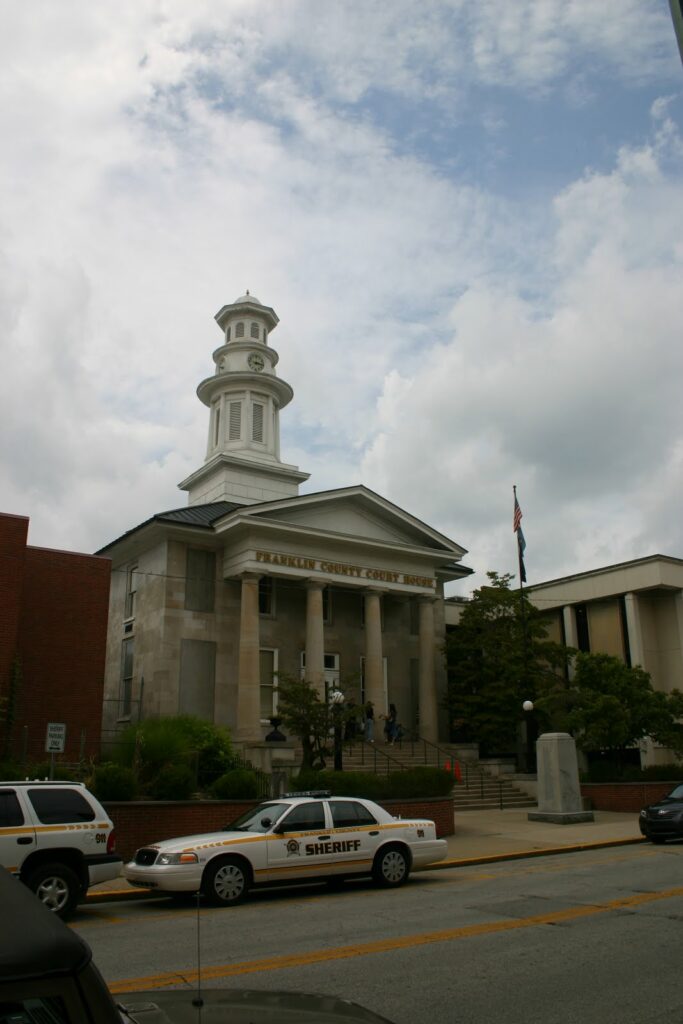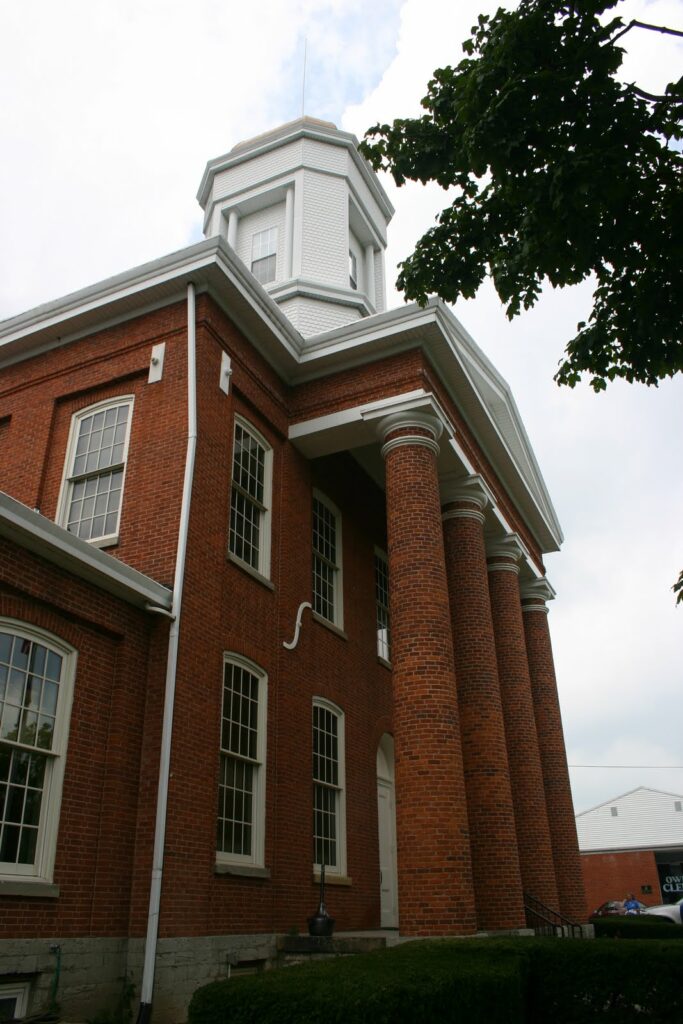
Okay, so I’ve never been a big fan of the Franklin County Courthouse. The city of Frankfort is pretty cool in spots – lots of older historic buildings. This is one of the few courthouses in Kentucky that I’ve been inside of as a reporter or law clerk, and I think that’s part of the problem. Its beautiful inside, but as far as the outside, it’s hidden down by the Kentucky River near Singing Bridge. Due to this weird location, I think it gets totally lost.
I actually know a lot about this building too, thanks to the historic Frankfort walking tour. According to the materials from the Franklin County/Frankfort Tourism Commission, the building was built in 1835, and designed by Gideon Shryock who designed a ton of buildings in Frankfort. It was remodeled in 1909, and an addition was added in 1949.
Owen County Courthouse – Owenton, Ky.
 Let me just say this at the start. Call me a nerd, but I have found that there is this really amazing feeling when you’re approaching the county seat and you see this towering courthouse cupola sticking up over the rest of the buildings between the trees. Especially when that towering courthouse is ridiculously awesome.
Let me just say this at the start. Call me a nerd, but I have found that there is this really amazing feeling when you’re approaching the county seat and you see this towering courthouse cupola sticking up over the rest of the buildings between the trees. Especially when that towering courthouse is ridiculously awesome.
So I decided to start this whole thing in a place that I’d never been to, and the winner was Owen County. Owen County is sort of an island right in the middle of the big triangle (between Lexington, Louisville and Cincinnati) and I’ve never had a reason to go there. So, I set out today with a map and a camera and no idea what I would find. The county seat of Owen County is (not surprisingly) Owenton. Anyway, I really thought this was an excellent way to start out the project. The building is pretty cool. It has these impressive brick columns and a really pretty little courthouse square. I looked it up on the National Register of Historic Places and it was built in the 1850s. Probably the coolest part is unseen in the above picture, as behind the courthouse is the old county jail, which is also on the National Historic Register.
The Kentucky 120 Project
Hello to all of Kaintuckeean’s readers (if they exist). My name is Nate, and Peter asked me to make a little project I’ve started this summer a feature of his blog.
So a few things first:
A few years ago, I was working for a weekly newspaper in Oldham County, Kentucky, and I stumbled on a web site. Somewhere in the Commonwealth, this guy was running a site where he posted pictures of all of the county courthouses in Kentucky that he had visited. I found this web site fascinating – one, because Kentucky has a TON of counties, and two, because I this is where I first began to see how amazing some of these courthouses were. The aforementioned web site has since disappeared, and before he quit, I think this guy got up to 50 or something which is actually pretty impressive. I mean, have you seen how some of these counties are shaped? Counties are crammed up in corners of the state with rivers and mountains restricting access by only a few state or U.S. roads.
But I’m a big history buff, and I love to drive, so the idea was intriguing.
Anyway, the other day a friend of mine posted an article on Facebook about an older couple that has been to every county in the state, and I thought to myself how awesome such a trip would be. But I wanted to do more than just visit each county – I needed something to remember each of them, something that would help define these little county seats in my mind. And so I decided to attempt to complete the courthouse project. For those unfamiliar with Kentucky, it has 120 counties, many of which are tucked away in tiny little corners of the state. And many of these courthouses are astounding. In the middle of a small town that maybe boasts one flashing red light will be this gigantic Greek revival courthouse.
So here I sit, post Kentucky Bar Exam with a month of time to kill and nothing to do. In the last few months leading up to the Bar I started making random drives into the Bluegrass to relieve stress, and I decided that it was about time I started having a point to all of this randomness.
So whenever I get the chance, I’ll be out in the Bluegrass with my camera, and instead of being embarassed by having to start my own blog, I’ll just post these random asides on Peter’s blog.
Hope you enjoy.
Nate
No Destination – June 5, 2009
Starting out in Nicholasville, we journeyed through Jessamine, Madison, Garrard, Mercer and Boyle counties. Here are some pictures from yesterday’s journey:
As always, there is a lot to learn in central Kentucky.
- Tates Creek Road in Lexington is the border – for several miles – between Jessamine and Fayette counties.
- The Valley View Ferry has a “perpetual and irrevocable” franchise issued by the Commonwealth of Virginia in 1785 (that’s why the Virginia flag also flies on the ferry). It has not since ceased operation. It has been operated by Madison, Fayette and Jessamine counties since 1991.
- “C6, H0” remains visible in Danville to remember when Centre College’s football team (in an undefeated season) beat Harvard, 6-0. It is the only graffiti that the Centre trustees permit on campus.
- What do they do with the dead? After the October 1862 Battle of Perryville, the Confederate forces quickly fled the area and a mass grave was constructed for the deceased rebel soldiers.
No Destinations – May 27, 2009
On May 27, we started in Fayette County and drove through Woodford, Franklin and Scott counties. It was a fun drive with an in-depth exploration of downtown Frankfort – the state’s capital. Learned:
- Bibb lettuce was developed in Kentucky
- Kentucky has an “official” covered bridge; it is the Switzer covered bridge in Franklin County
- Justice John M. Harlan, the lone dissenter in Plessy v. Ferguson (the case established the “separate but equal” doctrine, which was repudiated in Brown v. Board of Education; ) , lived for a time in Frankfort. In his famous dissent, Harlan wrote: “But in view of the Constitution, in the eye of the law, there is in this country no superior, dominant, ruling class of citizens. There is no caste here. Our Constitution is color-blind, and neither knows nor tolerates classes among citizens. In respect of civil rights, all citizens are equal before the law.”
